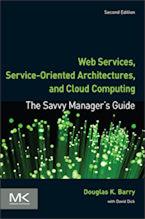Speaking on Advanced Software Architecture
Presentations
The following presentations may be individual keynotes or they may be assembled with consulting services into one-day or multi-day programs.
Web Services in Context
This presentation is an overview of Web Services, related standards, and technologies that can be used in service-oriented architectures. This presentation introduces the concepts of Web Services at a high level and then focus on the current state standards and which technologies make sense in a service-oriented architecture. One feature of this presentation is showing how Web Services address many of the technical barriers to systems integration.
Length: 60 to 90 minutes
Prerequisite: None
Audience: Non-technical management, technical management, and technical staff
Outline:
- Service-oriented architectures are not new
- The breadth of adoption of service-oriented architectures using Web Services is new
- Service-oriented architecture explained
- Services
- Connections
- Historical context for service-oriented architectures
- Blurring of internal and external services
- Web Services Explained
- Using the Web Services Description Language (WSDL)
- Using Universal Description, Discovery, and Integration (UDDI)
- Using SOAP
- Using XML with WSDL
- Importance of semantic vocabularies
- Common semantic vocabularies
- Specific semantic vocabularies
- Importance of being involved in the development of industry vocabularies
- Status of Web Services standards
- Future directions
Forces Affecting the Adoption of Web Services: A comparison to other integration techniques
This presentation shows the use of force-field analysis to help get a perspective on the forces affecting the adoption of Web Services and other integration techniques. Common system integration techniques will be presented approximately in chronological order. Chronological order allows us to see how, over time, advances in technology and standards have diminished the number of restraining forces, making change more likely to occur. Web Services will be shown as having the least number of restraining forces compared to any of the prior techniques. This is a great way to illustrate why Web Services can be seen as a wave of change in the software industry.
Length: 60 to 90 minutes
Prerequisite: General understanding of Web Services (the Web Services in Context presentation or equivalent)
Audience: Non-technical management, technical management, and technical staff
Outline:
- Force-field analysis overview
- Analysis of integration techniques
- Analysis of adopting enterprise-wide standards
- Adopting standard data element definitions
- Adopting standard, enterprise-wide software
- Analysis of middleware integration
- Adopting CORBA or DCOM
- Adopting Web Services
- Analysis of additional components used for integration in a service-oriented architecture
- Analysis of data warehousing
- Analysis of application or message routing
- Analysis of putting all the integration techniques together in a service-oriented architecture
Evolution of Information Technology: The likely impact of Web Services and service-oriented architectures
The use of Web Services has the potential to change IT as we know it. This presentation describes several change scenarios and how they will affect IT as well as other parts of an organization. It also provides suggestions on how to position your organization to take advantage of the opportunities presented by the changes related to Web Services.
Length: 60 to 90 minutes
Prerequisite: The Forces affecting the Adoption of Web Services presentation
Audience: Non-technical management, technical management, and technical staff
Outline:
- Initial impact of Web Services
- Evolutionary use
- Discussion of change
- Technical change issues diminishing
- Non-technical change issues may ncrease
- Resistance to change
- Overcoming resistance to change
- Change scenarios
- Consolidated force-field analysis for adopting a service-oriented architecture that includes change issues
- Tips for managing change issues during development
Enterprise Service-Oriented Architecture: Options for deployment
There are many options for deploying an enterprise service-oriented architecture. This presentation emphasizes middle-tier architectures and provides architectural options. It covers relevant data access standards and emerging specifications.
Length: 60 to 90 minutes
Prerequisite: General understanding of Web Services (the Web Services in Context presentation or equivalent)
Audience: Technical management and technical staff
Outline:
- Integration with existing architectures
- Classification of data-centric and process-centric architectures
- Middle-tier architectural options
- Caching options
- Persistence options
- Firewall options
- Relevant data access standards and specifications
Designing a Service-Oriented Architecture: How to incrementally implement Web Services
This presentation will show you how to incrementally adapt your systems into services. It is often surprising to see how differently your systems architecture may look when viewed through the lens of a service-oriented architecture. Example architectures will be used to illustrate how to incrementally move from your existing systems to a service-oriented architecture.
This presentation builds on the material from the Enterprise Service-Oriented Architectures: Options for deployment presentation and relates it to the material in the Evolution of Information Technology: The likely impact of Web Services and service-oriented architectures presentation.
Length: 60 to 90 minutes
Prerequisite: Basic understanding Web Services standards and related products (the Enterprise Service-Oriented Architectures: Options for deployment presentation or equivalent) and the Evolution of Information Technology: The likely impact of Web Services and service-oriented architectures presentation
Audience: Technical management and technical staff
Outline:
- Applying the stages of adoption for using Web Services to incrementally implement a service-oriented architecture
- Experiment with Web Services
- Adapt existing systems to use Web Services
- Remove intersystem dependencies
- Establish an internal service-oriented architecture
- Expand the internal service-oriented architecture to include external services
- Each stage will be illustrated using:
- Architectures
- Staffing suggestions
- Likely change issues and suggestions for dealing with those issues
Roundtable Discussions
This interactive session is designed to provide participants with the opportunity to get answers for their burning questions in a real-time setting. Any topic related to Web Services and service-oriented architectures is appropriate.
Douglas K Barry

Specializing in enterprise architecture with an emphasis in service-oriented architecture, database systems, and object technology, Doug Barry's practice is aimed at accelerating your understanding and use of software technology. An author, columnist, guest lecturer, international speaker, and mentor, his most recent book is Web Services, Service-Oriented Architectures, and Cloud Computing: The Savvy Manager's Guide.
More about Douglas K Barry
Doug's wide-ranging background and experience make him a knowledgeable speaker and discussion leader.
Public speaking venues
Doug has been a speaker at many industry conferences and trade shows over the years, including XML Web Services One, DAMA, COMDEX Enterprise, DB/Expo, The IT Forum, Java Expo, Object World, Software Development, Cutter Summit, The Object/Relational Summit, DCI Database World, Object/Expo, and SunWorld.
Private speaking venues
Doug has presented at corporate technology conferences, held private seminars, and chaired roundtable discussions on system integration and service-oriented architectures using Web Services and related technologies.
The Savvy Manager's Guide
Doug is the author of Web Services, Service-Oriented Architectures, and Cloud Computing: The Savvy Manager's Guide. Click here for more information on this book.

"Douglas Barry has provided a solid description of what are web services, how they can be used, how they are developed and what they are based on. His background work for many years with technology standards consortiums enables him to clearly show why the wide-spread adoption of web services is closely tied to the agreed use of common standard vocabularies and methods for inter-enterprise interactions.
The book is an easy read for managers, both business and technology managers, with clear example usage scenarios, extensive references and practical implementation guidelines.
Douglas Barry paints a clear picture of a future world where services are ubiquitous and easily integrated into the way we work and use information. It is a future that is easily within our grasps. But it will be a world where both users and providers of information change their thinking to a more service orientation. It is also a world where the technology features are implemented within industry frameworks of open standards."
Patrick Gannon
President and CEO, OASIS
Consulting and Mentoring
Speaking can be combined with our other services to best meet your needs. See:
Author
Douglas K Barry
Principal
